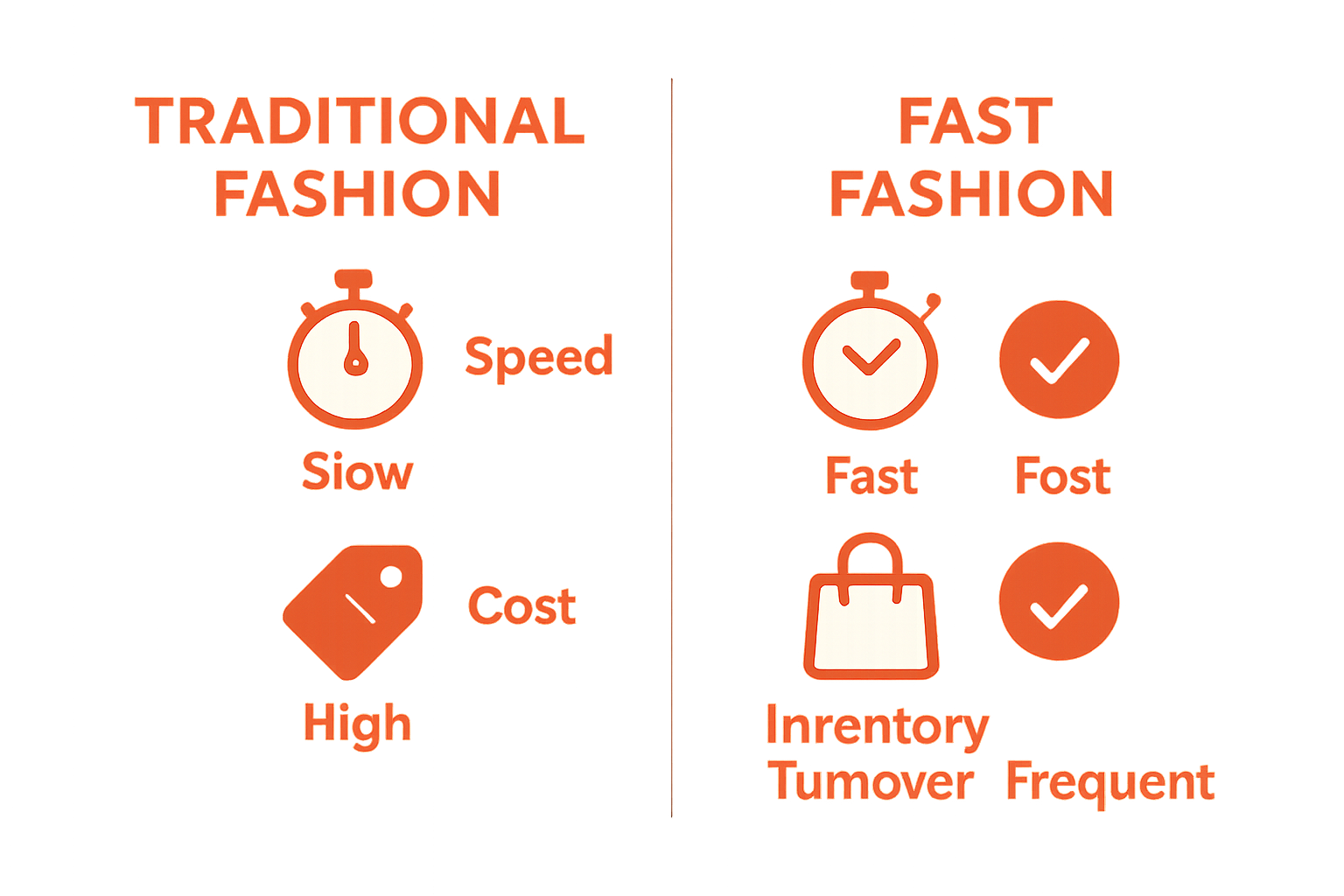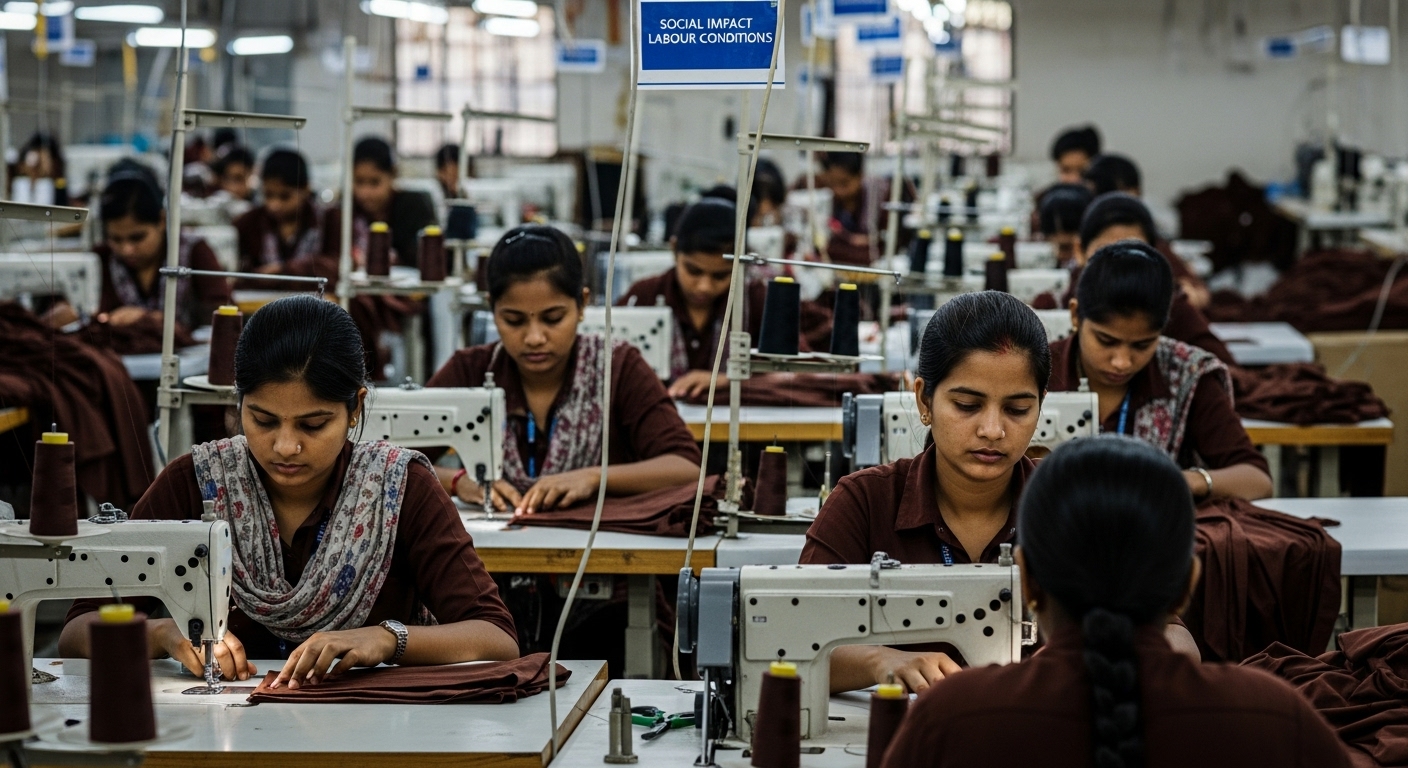
Understanding the Impact of Fast Fashion on Our World
Share
Fast fashion shops fill high streets and online feeds with endless racks of the latest styles at cut prices, changing what people wear in a matter of weeks. Shoppers snap up garments for pennies and wear them only a handful of times. Yet, beneath the thrill of a bargain, something staggering lurks. Textile production pumps out more greenhouse gas emissions than all international flights and shipping combined. It is not just about a wardrobe refresh. It is about choices that shape the planet and lives on the other side of the world.
Table of Contents
- What Is Fast Fashion And Its Characteristics?
- The Environmental Impact Of Fast Fashion
- Social Implications: Workers And Communities
- Consumer Behaviour And Fast Fashion Trends
- Shifting Towards Sustainable Fashion Alternatives
Quick Summary
| Takeaway | Explanation |
|---|---|
| Fast fashion prioritises speed and affordability | The fast fashion model accelerates production to deliver trendy clothes quickly at low prices. |
| Consumer demand drives repetitive consumption cycle | Fast fashion appeals to consumers seeking trendiness at low cost, fostering a throwaway culture. |
| Environmental impact is significant and harmful | Fast fashion contributes to extensive waste, pollution, and climate change due to rapid production cycles. |
| Social implications include labour exploitation | Workers, predominantly women in low-income countries, often face poor wages and unsafe conditions. |
| Sustainable fashion offers a viable alternative | Shifting to sustainable fashion promotes ethical production, quality materials, and environmental responsibility. |
What is Fast Fashion and Its Characteristics?
Fast fashion represents a transformative approach in the global clothing industry that prioritises rapid production, low cost, and trend responsiveness. This model fundamentally reshapes how clothing is designed, manufactured, and consumed in contemporary society.
The Core Characteristics of Fast Fashion
At its essence, fast fashion is a business strategy that rapidly translates runway trends into affordable clothing for mainstream consumers.
 According to research from Penn State University, fast fashion is characterised by several key attributes:
According to research from Penn State University, fast fashion is characterised by several key attributes:
- Extremely quick turnaround from design to retail
- Highly affordable price points
- Mimicking current runway and celebrity fashion trends
- Frequent inventory updates and new style introductions
- Low manufacturing quality to maintain low prices
The Mechanics of Fast Fashion Production
The fast fashion model operates through an intricate global supply chain designed for maximum efficiency and minimal cost. Retailers like Zara and H&M have perfected a system where design teams can conceptualise a garment and have it available in stores within weeks. This approach relies on complex global manufacturing networks, predominantly in countries with lower labour costs.
Production Speed: Brands can move from design concept to retail shelf in as little as two weeks, compared to traditional fashion cycles that might take months.
Economic and Consumer Dynamics
Consumers are drawn to fast fashion for its accessibility and trend alignment. The ability to purchase trendy clothing at minimal cost has fundamentally altered shopping behaviours. Research from the University of Wisconsin highlights that this model creates a continuous cycle of consumption, where clothing is viewed as disposable rather than a long-term investment.
The fast fashion phenomenon has democratised fashion, allowing individuals from various economic backgrounds to participate in trending styles. However, this accessibility comes with significant environmental and ethical consequences that are increasingly under scrutiny in global discussions about sustainable consumption.
The Environmental Impact of Fast Fashion
The environmental consequences of fast fashion extend far beyond simple clothing production, representing a complex global challenge with profound ecological implications. This industry’s practices contribute significantly to environmental degradation through multiple interconnected mechanisms.
Resource Consumption and Waste Generation
According to the European Environment Agency, textile production creates substantial environmental pressure. The industry’s resource consumption is staggering:
- Massive water usage in cotton cultivation and fabric production
- High energy consumption during manufacturing processes
- Significant chemical pollution from textile dyeing and treatment
- Enormous volumes of textile waste in landfills
- Microplastic shedding from synthetic fabrics
Carbon Footprint and Greenhouse Gas Emissions
Fast fashion’s carbon footprint is remarkably disproportionate to its perceived value. Textile production generates more greenhouse gas emissions than international shipping and maritime transport combined. The global supply chains, involving multiple manufacturing stages across continents, exponentially increase carbon emissions through transportation and industrial processes.
Ecosystem and Biodiversity Disruption
The environmental impact extends beyond immediate production metrics. Fast fashion contributes to ecosystem destruction through:
- Deforestation for cotton and synthetic fabric production
- Water system contamination from industrial chemical runoff
- Soil degradation in agricultural regions supporting textile crops
- Destruction of marine ecosystems through microplastic pollution
The rapid consumption cycle encourages a throwaway culture where garments are discarded after minimal use, creating a perpetual loop of environmental damage. While consumers enjoy low-cost trendy clothing, the ecological price remains substantially high and increasingly unsustainable.
To break down the main environmental impacts discussed in the article, the following table summarises the different ways fast fashion affects ecosystems and natural resources.
| Environmental Impact | Description |
|---|---|
| Water Consumption | Massive volumes used in cotton cultivation and textile production |
| Energy Use | High during manufacturing and delivery cycles |
| Chemical Pollution | Toxic substances released from dyeing and fabric treatments |
| Textile Waste | Large amounts of discarded garments contributing to landfill |
| Microplastic Shedding | Synthetic fibres released into the environment, especially oceans |
| Greenhouse Gas Emissions | More than those from international shipping and aviation combined |
| Biodiversity Disruption | Deforestation, soil degradation and aquatic system damage |
Social Implications: Workers and Communities
The fast fashion industry represents more than an economic model; it is a complex social ecosystem with profound human consequences that extend far beyond clothing production. The social ramifications touch workers, their families, and entire communities in intricate and often devastating ways.
Labour Conditions and Economic Vulnerability
According to research from Washington University, workers in the fast fashion supply chain face extreme economic and social challenges. The industry predominantly employs women in low and middle-income countries, creating a system of systematic economic exploitation:
- Extremely low wages below living standards
- Unsafe working environments
- Limited job security
- Minimal worker protection and rights
- Generational cycles of poverty
Gender Dynamics and Social Inequality
Fast fashion’s labour model disproportionately impacts women, who constitute the majority of garment workers globally. The industry creates a complex web of gender-based economic vulnerability, where women are simultaneously critical to production and most disadvantaged by its structures.
Key Gender Impact Indicators:
- Women represent approximately 80% of garment workers worldwide
- Predominantly young women aged 18-35
- Limited opportunities for career advancement
- High risk of workplace harassment and discrimination
Community and Systemic Consequences
The social impact of fast fashion extends beyond individual workers, fundamentally reshaping entire community economic landscapes. Manufacturing regions become dependent on these industries, creating complex socioeconomic dynamics where entire communities are tethered to global fashion consumption patterns.
While fast fashion provides employment in regions with limited economic opportunities, it simultaneously perpetuates a cycle of economic precarity. Workers are trapped in a system that offers minimal wages, dangerous working conditions, and little prospect for meaningful economic mobility.

Understanding these social implications requires recognising fast fashion not just as a consumer trend, but as a global system with profound human consequences that challenge fundamental notions of ethical production and economic justice.
Consumer Behaviour and Fast Fashion Trends
Consumer behaviour in the fast fashion landscape represents a complex interplay of psychological, social, and economic factors that drive purchasing decisions and consumption patterns. Understanding these dynamics reveals the intricate mechanisms behind the industry’s persistent global appeal.
Psychological Drivers of Fast Fashion Consumption
Instant Gratification and Trend Accessibility play crucial roles in shaping consumer engagement with fast fashion. According to the European Parliament, consumers are increasingly motivated by several key psychological factors:
- Desire to immediately participate in current fashion trends
- Low financial barrier to entry
- Social media influence and visual consumption
- Perceived social status through clothing
- Continuous novelty and style refreshment
Economic and Social Motivations
Fast fashion’s appeal transcends mere clothing acquisition. It represents a sophisticated social mechanism where consumers can:
- Express personal identity through affordable clothing
- Experiment with multiple style personas
- Align with contemporary aesthetic standards
- Manage social perceptions through visual presentation
Emerging Consumer Consciousness
Recent trends indicate a significant shift in consumer perspectives. Young consumers are increasingly critical of fast fashion’s environmental and social consequences, demonstrating growing awareness about sustainable consumption.
While price and accessibility remain primary drivers, an emerging demographic is willing to invest in more sustainable and ethically produced clothing. This transition suggests a potential long-term transformation in fashion consumption patterns, where quality, durability, and ethical production become progressively more important than immediate trend participation.
The complexity of consumer behaviour in fast fashion reveals a nuanced landscape where economic constraints, psychological desires, and emerging ethical consciousness continuously interact and reshape purchasing dynamics.
Shifting Towards Sustainable Fashion Alternatives
Sustainable fashion represents a holistic reimagining of clothing production, consumption, and lifecycle management that challenges the destructive paradigms established by fast fashion. This transformative approach seeks to integrate environmental responsibility, ethical labour practices, and long-term economic sustainability.
Principles of Sustainable Fashion
According to research from Corvinus University, sustainable fashion encompasses comprehensive strategies that go beyond mere product design. The core principles focus on creating systemic change within the fashion ecosystem:
- Prioritising durable, high-quality materials
- Implementing circular design principles
- Reducing overall environmental footprint
- Ensuring fair labour practices
- Promoting transparency in supply chains
Innovative Production and Consumption Models
Emergent sustainable fashion alternatives challenge traditional manufacturing and consumption paradigms by introducing revolutionary approaches:
- Rental and clothing exchange platforms
- Upcycling and textile recycling initiatives
- Made-to-order production reducing waste
- Local and small-scale manufacturing
- Investment in regenerative textile technologies
Consumer Empowerment and Systemic Transformation
The shift towards sustainable fashion requires active participation from consumers, designers, and policymakers.
Individual choices can collectively drive meaningful industry transformation. Consumers are increasingly recognising their power to influence production practices through informed purchasing decisions, supporting brands that demonstrate genuine commitment to environmental and social responsibility.
This transition is not merely about changing clothing but reimagining our relationship with fashion itself. By valuing quality over quantity, longevity over trendiness, and ethical production over rapid consumption, sustainable fashion offers a compelling alternative to the destructive fast fashion model.
To clarify the key differences between fast fashion and sustainable fashion approaches, the following table presents a direct comparison of their defining principles and impacts.
| Aspect | Fast Fashion | Sustainable Fashion |
|---|---|---|
| Production Speed | Extremely rapid, turnaround from design to retail in weeks | Deliberate, slower production cycles |
| Price Point | Highly affordable, low-cost | Generally higher, reflecting quality and ethics |
| Material Quality | Low quality, prioritising cost reduction | Durable, high-quality materials |
| Environmental Impact | High resource consumption, waste, pollution | Reduced footprint, circular design, minimises harm |
| Labour Practices | Often exploitative, poor wages and conditions | Fair labour standards and transparency |
| Trend Responsiveness | Mimics current trends immediately | Timeless, prioritises longevity over fleeting trends |
| Supply Chain Transparency | Limited, opaque supply chains | Transparent, traceable, and ethical sourcing |
The journey towards sustainable fashion represents a profound cultural and economic reimagining, where clothing becomes a reflection of personal values, environmental stewardship, and collective responsibility.
Choose Timeless Quality Over Fast Fashion
Are you feeling overwhelmed by the disposable cycle and hidden costs of fast fashion highlighted in the article? The relentless pursuit of fleeting trends and low-cost garments often comes at the expense of the environment, fair labour, and true craftsmanship. If you want to make a conscious shift away from throwaway culture and towards lasting, ethical style, you are not alone. Many readers are looking for ways to support sustainable fashion and invest in pieces that have a meaningful impact.

Discover the difference at San Rocco Italia, where every luxury handbag and accessory embodies the lasting values of meticulous Italian craftsmanship. Our woman-owned boutique offers timeless design and superior materials, thoughtfully sourced from trusted makers across Europe. Each purchase supports skilled artisans, ethical production, and environmental responsibility. Take a stand for quality and authenticity today by exploring our current collection at San Rocco Italia. Experience fashion that endures—start your journey now.
Frequently Asked Questions
What is fast fashion?
Fast fashion is a business model that rapidly produces affordable clothing by translating runway trends into consumer-ready garments, often with a focus on quick turnaround and low production costs.
How does fast fashion impact the environment?
Fast fashion contributes significantly to environmental degradation through high resource consumption, substantial carbon emissions, and increased textile waste, leading to serious ecological consequences.
What are the social implications of fast fashion?
The fast fashion industry often exploits workers, particularly women in low-income countries, subjecting them to low wages, poor working conditions, and limited rights, creating a cycle of economic vulnerability.
How can consumers shift towards sustainable fashion?
Consumers can embrace sustainable fashion by prioritising high-quality, durable clothing, supporting brands committed to ethical production, and engaging in practices such as upcycling, renting, or exchanging garments.


